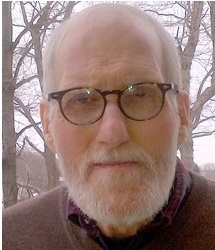David Weis is a world-renowned Wyckoff expert and a contributor to www.richardwyckoff.org where he is going to be running a course on Point and Figure charting.
His book Trades About to Happen: A Modern Adaptation of the Wyckoff Method is due to be published in 2012.
Below is an Interview between Gavin Holmes (GH) and David Weis (DW).
GH: How did you get involved in trading and investing in the markets?
DW: I was working in Louisiana whilst studying for a PhD in English Literature (on ‘black’ dialect). One day I saw a graffito which gave me a sobering lesson in the law of supply and demand: English teachers are a dime a dozen! Although I had planned to stay in academic life, a visit to a friend in the research department of a commodity brokerage company in our hometown of Memphis, Tennessee, made me change my mind. I joined the technical research department, compiling charts by hand, and was soon making money; by the time the markets heated up in 1970 I had become a technical analyst, and carried on from there.
GH: That sounds very much like Tom Williams, who began as a chartist for a hedge fund in Beverly Hills. And how long have you been trading and investing?
DW: For 40 years, since 1971.
GH: Now you’re an acknowledged expert in Wyckoff methodology, and Point and Figure charting. How did you come across the work of Wyckoff, and why is his work still so valuable to traders today?
DW: In those days people who knew about, and profited from, Wyckoff, tended to keep it to themselves. I learned about it from one of my accountants (by this time I was a broker as well as an analyst), who very kindly arranged, and paid, for my tuition. It did not take long for my new knowledge to pay me substantial dividends!
GH: Again, much like Tom Williams, who also studied Wyckoff. The thing about the Wyckoff method is that it’s not a ‘Black Box’ approach. Can you describe, or summarize, the Wyckoff method of trading?
DW: In the Wyckoff method you’re listening to what the market says about itself, and acting on market-generated information. There’s no interaction with any mathematical information, the news, or any tips about the future: just what the market says about itself. The essence of the method is to develop an intuitive judgment based on close and prolonged study of market movements. Although Wyckoff lived in the days of ticker tape, when trading was confined mainly to stocks and commodities, his method is just as applicable to chart reading and the much greater range of tradable instruments that we have today.
GH: Why do you think the Wyckoff method becoming so popular again?
DW: I think there is now a greater understanding of the limitations of mathematically generated indicators. Such indicators try to predict the future by analyzing the past, but experience shows that they are far from infallible. The main problem with indicators such as MACD, Stochastics, and RSI, is that they are lagging indicators, and traders are now realizing that the key to success lies in learning what the market is telling you at the leading edge of the chart in order to predict with a high degree of certainty which way the market will move in the future.
GH: So, what are some of the things Wyckoff would encourage us to look at when analyzing the market?
DW: Essentially, Wyckoff was interested in the spread of the price bar, the position of the close, and the volume. Also of interest were the duration of moves and the interaction of the prices bars with trend lines, support and resistance lines, and channels.
GH: This is much the same as what VSA is about: the range (spread) of the bar, the volume, the closing price in relation to that volume, and analysis of the “background” and thus we get to certain support and resistance levels (what I call trigger numbers) where those levels form an area of high probability trading, because everything is lining up in your favor.
My next question is on Point and Figure charting, with which many readers may not be familiar. Can you tell us a bit about it, and why it can be relevant in today’s markets?
DW: Point and figure seems to have fallen out of favor today, but Wyckoff, in his first course, says that this is the most important chart to maintain; if you study the course you will see just how much emphasis there is on Point and Figure.
A bar chart shows the price spread, and the open and close for the period in question, be it days, weeks or whatever. The point and figure chart, on the other hand, easily enables your to adjust your analysis by changing the box sizes and the reversal factor.
For example, Point & Figure charting is superb in its ability to reduce “market noise” by selecting e.g. a box size of 10pips x 3 boxes. This means that we plot three boxes only when the market has moved (10×3) =30 pips in either direction (up or down). This methodology eliminates market noise and enables the trader to get a better view of market dynamics. As a little bit of background on a very large subject, Point & Figure was plotted early in its history as depicting market price movement with a series of X’s and O’s. These days it is more popularly shown as different colored “boxes”.
For those interested in the development history of P&F, Richard Wyckoff’s book, Stock Market Techniques published in 1933, stated that the “one point figure chart” is the standard for stocks. (Wyckoff’s book discusses Figure charts constructed with figures. This is not to be confused with Point & Figure charts, which followed later, as the idea developed)
To Wyckoff the most important thing about the Point and Figure chart were the horizontal areas, the lines of congestion, from which you can make a Point and Figure target projection of the extent of a move. Point and Figure charts give very reliable buy & sell signals, and perhaps more importantly indicate the breakout direction of the market above or below the congestion areas, in effect showing the trader exactly where the cause was being built for an effect.
You’d combine the use of a standard bar chart and volume to get additional confirmation of the future direction. Point & Figure charts also give reliable price targets, as well as show the VSA corroborative situation by virtue of the fact that a line of up boxes clearly shows demand and a line of down boxes indicates supply.
(In his earliest work Wyckoff did, in fact, devise some charts, which incorporated volume with Point and Figure; he obviously recognized how very helpful volume combined with point and figure oscillation could be.)
In summary, Point and Figure is measuring cause and potential: the strength of the lateral movement from which to project up or down.
GH: So, as far as it is going to help the trader, the Point and Figure chart is going to help him select a Point & Figure signal which will form the basis of where to eventually take profit, a point which may, indeed, be much further away than one chosen without the aid of Point and Figure.
We could conclude by saying that Point and Figure accurately depicts the precise price levels where price has reversed or risen, which in effect can therefore be regarded as graphically showing price activity volume.
It is this volume that can be correlated to the various trading signals that are given out by TradeGuider, based on the software’s analysis of the volume at the chosen price level. The proper and combined use of Point & Figure with TradeGuider will lessen the amount of volume analysis needed to take high probability trades, and by implication will reduce even further the chances of making analytical mistakes or misinterpretations.
Về Gavin Holmes

Gavin is the author of Trading in the Shadow of the Smart Money. Gavin has helped thousands of traders in over 36 countries learn how to track the “Smart Money” and avoid the tricks that the “Smart Money” play. Gavin was taught to trade by the late veteran syndicate trader, Tom Williams and was fortunate enough never to have picked up the bad habits that many retail traders suffer from. Gavin is now based in the UK and regularly hosts seminars and events sharing his experience and knowledge developed through talking to hundreds of retail traders each month, most who are finding the markets a challenging environment. Most recently he has hosted a live trading presentation at the CME Headquarters in Chicago.

